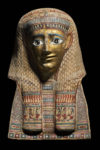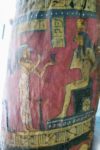 Manchester Museum, part of The University of Manchester, is undergoing a huge £13-million, three-year renovation that requires the closure of multiple galleries for the duration. Egyptian Worlds, which houses Manchester Museum’s extensive collection of mummies and artifacts from 5,000 years of Egyptian history, is among them. The galleries closed in August 2018 and are scheduled to reopen in 2021 in the transformed museum.
Manchester Museum, part of The University of Manchester, is undergoing a huge £13-million, three-year renovation that requires the closure of multiple galleries for the duration. Egyptian Worlds, which houses Manchester Museum’s extensive collection of mummies and artifacts from 5,000 years of Egyptian history, is among them. The galleries closed in August 2018 and are scheduled to reopen in 2021 in the transformed museum.
 While the collection’s home is being rebuilt, Manchester Museum has arranged the first travelling exhibition of some of its most exceptional pieces from Greco-Roman Egypt (c. 300 B.C. – 200 A.D.). Golden Mummies of Egypt is centered around eight mummies unearthed over a century ago during University of Manchester excavations in Egypt. Through the mummies and other artifacts, including the always-evocative Fayuum mummy portraits, the exhibition explores beliefs about death and the afterlife from Greek and Roman Egypt and their link to the ancient traditional religion of dynastic Egypt.
While the collection’s home is being rebuilt, Manchester Museum has arranged the first travelling exhibition of some of its most exceptional pieces from Greco-Roman Egypt (c. 300 B.C. – 200 A.D.). Golden Mummies of Egypt is centered around eight mummies unearthed over a century ago during University of Manchester excavations in Egypt. Through the mummies and other artifacts, including the always-evocative Fayuum mummy portraits, the exhibition explores beliefs about death and the afterlife from Greek and Roman Egypt and their link to the ancient traditional religion of dynastic Egypt.
The latest technology will give visitors a literal view from the inside.
The exhibition includes 360 degree interactive CT-scans of each mummy on display, allowing the visitor to see beneath the wrappings; audio-visual translations of texts bring the words of ancient people to life; iconographic visualisations animate the gods the Egyptians hoped to meet.
Golden Mummies of Egypt opens in the US at the Buffalo Museum of Science on February 8th, 2020. Its next stop will be the North Carolina Museum of Art where it will run from September 19, 2020, through January 10, 2021.



A correct alphabetical order is not to be underestimated, i.e. in life as in the afterlife.
Isaiousa’s mummy is labelled in Greek as “Isaious(a/d)e..” (isaiomai=resemble).
Unfortunately we cannot see the rest, but this might be the Ptolemaic translation of an originally Egyptian name.
——–
PS: Why is it that, whenever Greek letters are contained, the post wont appear. –That’s Prejudicialsm!
Source: trismegistos.org/fayum/fayum2/747.php?geo_id=747
——–
“…Out of the 516 known texts found at Hawara 507 are written in Greek (98.3 %). Two Latin literary texts (LDAB 4141; LDAB 4473 – 1st-2nd century AD), one bilingual Greek-Latin papyrus (3rd-4th century AD) and seven Coptic papyri (5th-7th century AD) were found on the site. Hieratic and demotic fragments are very rare…”
——–
:hattip:
I was once ROT 13’d by a server when I was asked to explain why there were more sounds in classical Egyptian than in English. I used a couple of Arabic and Hebrew characters, which called for Windows’ extended font, and that did it. A couple of friends, on the same list, told me that the server was convinced the post was X-rated.